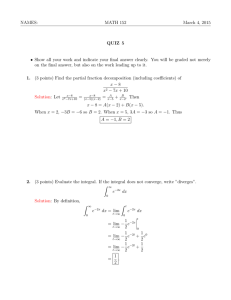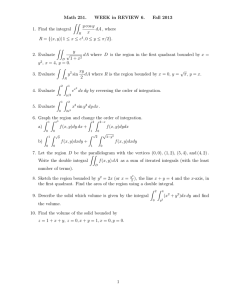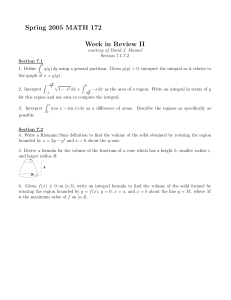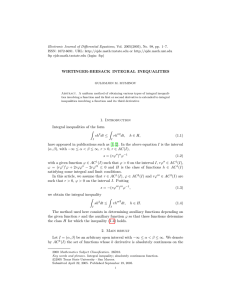15 ON THE LIMIT OF A SEQUENCE (1999), 35{40
advertisement
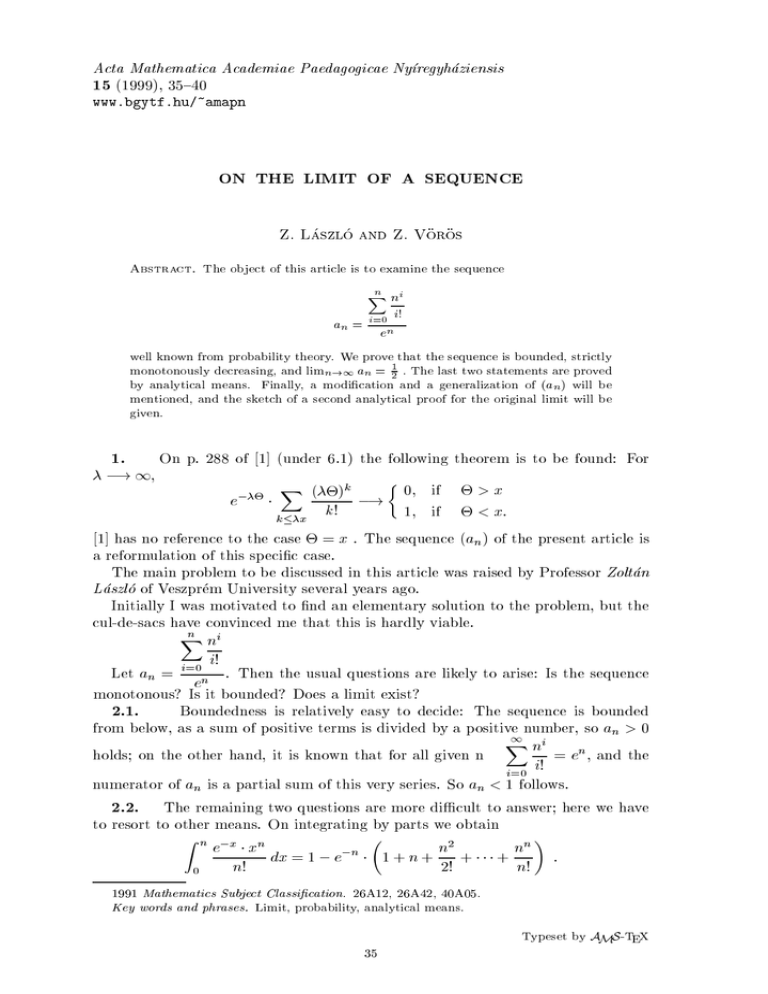
Acta Mathematica Academiae Paedagogicae Nyregyhaziensis
15 (1999), 35{40
www.bgytf.hu/~amapn
ON THE LIMIT OF A SEQUENCE
szlo
and Z. Vo
ro
s
Z. La
Abstract. The object of this article is to examine the sequence
X
n
an
=
i
n
i=0
en
i
!
well known from probability theory. We prove that the sequence is bounded, strictly
monotonously decreasing, and limn!1 an = 21 : The last two statements are proved
by analytical means. Finally, a modication and a generalization of (an ) will be
mentioned, and the sketch of a second analytical proof for the original limit will be
given.
1. On p. 288 of [1] (under 6.1) the following theorem is to be found: For
,! 1,
X ()k 0; if > x
,
,! 1; if < x:
e
k!
kx
[1] has no reference to the case = x . The sequence (an ) of the present article is
a reformulation of this specic case.
The main problem to be discussed in this article was raised by Professor Zoltan
Laszlo of Veszprem University several years ago.
Initially I was motivated to nd an elementary solution to the problem, but the
cul-de-sacs have
convinced me that this is hardly viable.
n
X ni
i!
Let an = i=0en . Then the usual questions are likely to arise: Is the sequence
monotonous? Is it bounded? Does a limit exist?
2.1.
Boundedness is relatively easy to decide: The sequence is bounded
from below, as a sum of positive terms is divided by a positive1 number, so an > 0
X ni n
holds; on the other hand, it is known that for all given n
= e , and the
i
!
i=0
numerator of an is a partial sum of this very series. So an < 1 follows.
2.2. The remaining two questions are more dicult to answer; here we have
to resort to other means. On integrating by parts we obtain
n2
nn
,
n
dx = 1 , e 1 + n + + +
:
n!
2!
n!
0
1991 Mathematics Subject Classication. 26A12, 26A42, 40A05.
Key words and phrases. Limit, probability, analytical means.
Z n e,x xn
35
Typeset by AMS-TEX
OS
Z. LA SZLO AND Z. VOR
36
So for an
an = 1 ,
Z n e,x xn
n!
0
dx :
Now we shall prove that the sequence (an ) is strictly monotonously decreasing.
Statement:
an > an+1 .
Proof:
By reason of the above formula for an we are to show that
Z n e,x xn
0
n!
Z n+1 e,x x(n+1)
dx <
(n + 1)! dx :
0
By decomposition of the integral
Z n+1 e,x x(n+1)
Z n e,x x(n+1)
Z n+1 e,x x(n+1)
(n + 1)! dx = 0 (n + 1)! dx + n
(n + 1)! dx :
Hereafter we shall denote the rst and second integrals on the right side by I1 , and
I2 respectively.
First we shall give an estimate for I2 . For the derivative f 0 (x) of the function
0
f (x) :=
e,x xn
f 0 (x) =
n!
e,x x(n+1)
(n + 1)!
x
1 , n + 1 0 ; if
x 2 [0; n + 1] ;
which means that in this interval f (x) is monotonously increasing. So
e,n n(n+1)
I2 1 (n + 1)! :
Let us deal now with the rst integral. By integration by parts
I1 =
n Z n e,x xn
e,x x(n+1)
dx :
(n + 1)! dx = , (n + 1)! 0 + 0
n!
Z n e,x x(n+1)
0
So we obtain that
Z n+1 e,x x(n+1)
0
(n + 1)!
,n
(n+1)
dx = I2 +
Z n e ,x x n
0
n!
dx +
Z n e,x xn
0
n!
e,n nn+1
(n + 1)!
dx ,
e,n nn+1
(n + 1)!
,n n+1
, e (n + n1)!
;
as I2 e (n+n 1)! . }
Thus we have proved that the sequence (an ) is bounded from below and strictly
monotonously decreasing, consequently a limit exists.
ON THE LIMIT OF A SEQUENCE
37
2.3. Next, we shall try to nd this limit. To this end, we are going to use the
following lemma (without proof):
Lemma:
e n
n
whence
1
p
n! = 2n + O pn
nn
=
n! en
(1)
;
p 1 1 + O n1 :
2n
(The proof can be found in numerous places. E.g. [3].)
>From the formula for an
lim a
n!1 n
= 1 , nlim
!1
Z n e,x xn
n!
0
dx ;
so, to nd the limit of the sequence, we have to calculate
Z n e,x xn
lim
n!1 0
n!
dx:
Let = n, +" , where 0 < " < 16 . Then, by the substitution x = n (z + 1)
1
2
Z n e,x xn
0
dx =
n!
Z 0 e,n(z+1) (z + 1)n n(n+1)
n!
,1
rn Z0
nn
dz = n
e,nz (z+1)n =
n! en ,1
1 Z 0 = 2 1 + O n e,z (1 + z ) n dz =
,1
(Here we used Lemma (1) .) Transforming the integral further
rn 1 Z 0 = 2 1 + O n e,z (1 + z ) n dz =
,1
rn 1 Z , Z0
n
n
,
z
,
z
e (1 + z ) dz +
e (1 + z ) dz :
= 2 1 + O n ,1
,
As for the derivative f 0(z) of the function f (z) := e,z (1 + z) f 0(z) = ,e,z z,
for z 0 f 0 (z) 0 holds, which means that the above function is monotonously
increasing in the interval [,1; ,]. So
Z , ,1
e,z (1 + z ) n dz < (1 , ) e, (1 , ) n < e, (1 , ) n ;
that is, for the above integral
rn 1 Z 0 e,z (1 + z ) n dz =
1
+
O
2
n
,1
rn 1 Z 0 p ,
n
,
z
= 2 1 + O n e (1 + z ) dz + O n e
,
1
2
n2"
:
OS
Z. LA SZLO AND Z. VOR
38
On the remaining segment of the interval, using the equalities
f (z ) = eln f (z) ; and ln f (z ) = ,z + ln (z + 1) ;
(z 2 [,; 0]), and MacLaurin's series for the function ln (z + 1) :
z
2,
ln (z + 1) =
z2
z3
3 + 4 (1 + #(z))4
for the expansion of the integrand we obtain
2
3
4
, z2 + z3 , 4 (1 +z #(z))4
f (z ) = e
where 0 < #(x) < 1. The factor e,n
integral assumes the following form
z
#z
4
4(1+ ( ))4
;
,
is of the form 1 + O n,1+n" so the
z2 z3 0
1
1
rn Z
2
"
0
,
n
,
,
e
2 3 dz + O @pn e, 2 n A :
1
+
O n,1+4" 2
,
It is known that
z3
en 3 = 1 + n Z0
and
,
,
+
O n,1+6" ;
3
z3
en 2 dz
z2
,
is of the order n,1=2, the order term in en z is O n,1+6" , so
3
3
rn
z2 z3 rn Z
0 ,n
,3
,
,
1+4
"
2
e
dz =
2 1 + O n
,
,
Z 0 z ,
z3
= 2 1 + O n,1+4" e,n 1 + n 3 dz + O n1+6" =
,
#3 Z
0
,
#
1
,
=p e
1 + 3pn d# + O n,1+6" =
2 ,n"
Z0 #
Z 0 #3 e, #
,
1
1
,
d# + O n,1+6" :
=p d# + p
e
2 ,1
2n ,1 3
The rst integral equals 1=2 (Gaussian integral), while the second one will be transformed further:
2
2
2
2
2
2
2
2
Z0
,1
#2
#3 e, 2
3
d# = ,
"
#2 # 0
#2 e, 2
3
Z0
h , # i0
#
2
2
2:
,
+3
#e
d# = 0+ ,e
=
,
3
3
,1
,1
,1
2
2
2
2
ON THE LIMIT OF A SEQUENCE
39
(using integration by parts). Thus, for the limit
1 , 2 = 0 ; es
p
lim
n!1 2n
3
,n,1+6" = 0 ;
lim
O
n!1
i.e. the value of the original integral is 12 , so we have proved the following
1: }
Theorem: nlim
a
=
n
!1
2
3.1. Remark:
Dening the sequence bn as
2n ni
X
i!
bn = i=0n
e
it can be shown that this sequence is strictly monotonously
Z nincreasing.
Z n Integration
by substitution is used and the relationship f g =)
f g is applied.
0
0
Boundedness is proved in practically the same manner as in the previous case.The
calculation of the limit is performed similarly, and
lim b
n!1 n
=1:
is obtained.
Moreover, it can be shown that by modifying the limits of the summation the
limit can assume any value in the interval [0,1].
3.2. Remark:
To give a further proof for the limit of (an ) we shall use
the following theorem: (p. 128 of [2])
If the functions '(x), h(x) and f (x) = eh(x) dened for the nite or innite
interval [a; b] satisfy the following conditions:
(i) '(x) [f (x)]n is absolute integrable in [a; b] for 8 n 2 N ,
(ii) h(x) assumes its maximum only in of (a; b), and the least upper bound
of h(x) is less than h( )-t for all closed intervals not including ; furthermore, a
neighbourhood of exists such that h00 (x) exists and is continuous; nally, h00 (x) <
0,
(iii) '(x) is continuous in x = , '(x) 6= 0,
then, for 8 2 R
Z + pn
a
'(x) [f (x)]n dx
p
'( ) enh() 1
p,n h00() Z c
,1
t2
e, 2 dt ; (2)
where c = ,h00( ). }
Let now a = 0, b = n + 1, '(x) 1, = 0. So condition (iii) is satised.
Let h(x) = ln x , nx , lnnn! . Then h0 (x) = x1 , n1 , whence we get that h has got a
maximum in x = n, and h(x) is strictly monotonously increasing in (0; n], is strictly
40
OS
Z. LA SZLO AND Z. VOR
monotonously decreasing in [n; 1), and = n. , x12 < 0, so condition (ii) is also
automatically satised.
On the other hand,
1 , (n , 1) = Z 1 e,x xn dx
n!
n!
0
is absolute integrable, so (i) is also satised. Substituting this for formula (2) we
get
Z n e,x xn
Z0 t
e,n nn 1
dx q1 e, dt ;
n
!
n
!
0
,1
2
2
n
then, using Stirling's Formula the result 1=2 is received.
References
[1] Feller, W., Vvedenie v teori verotnoste i ee priloeni,
Moscow, 1967.
[2] Polya, Gy. and Szeg}o, G., Feladatok es tetelek az analzis koreb}ol I., Budapest, 1980.
[3] Ruzsa, Z. I., Multiplikatv szamelmelet, Budapest, 1996, manuscript.
(Received December 17, 1998)
Zoltan Laszlo , Department of Mathematics, Veszprem University,
Zoltan Vo ro s, Tiszavasvari ICN Hungary
